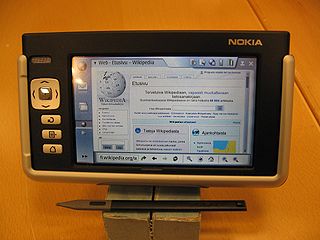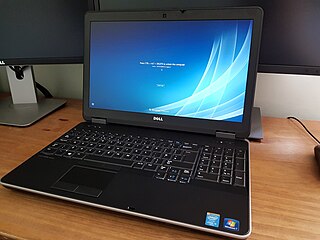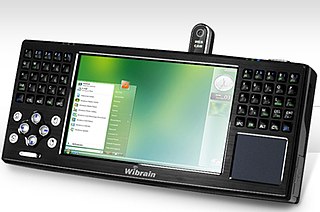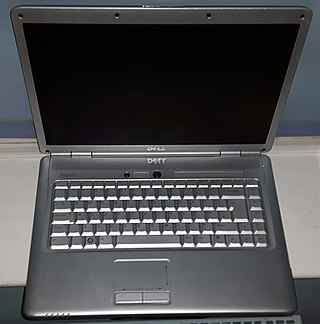Related Research Articles

MontaVista Software is a company that develops embedded Linux system software, development tools, and related software. Its products are made for other corporations developing embedded systems such as automotive electronics, communications equipment, mobile phones, and other electronic devices and infrastructure.

A netbook is a small-sized laptop computer; they were primarily sold from 2007 until around 2013, designed mostly as a means of accessing the Internet and being significantly less expensive.
Computer operating systems based on the Linux kernel are used in embedded systems such as consumer electronics, in-vehicle infotainment (IVI), networking equipment, machine control, industrial automation, navigation equipment, spacecraft flight software, and medical instruments in general.
In computing, instant-on is the ability to boot nearly instantly, allowing to go online or to use a specific application without waiting for a PC's traditional operating system to launch. Instant-on technology is today mostly used on laptops, netbooks, and nettops because the user can boot up one program, instead of waiting for the PC's operating system to boot. This allows a user to launch a single program, such as a movie-playing program or a web browser, without the need of the whole operating system. There still remain a few true instant-on machines such as the Atari ST, as described in the Booting article. These machines had complete Operating Systems resident in ROM similar to the way in which the BIOS function is conventionally provided on current computer architectures. The "instant-on" concept as used here results from loading an OS, such as a legacy system DOS, with a small hard drive footprint. Latency inherent to mechanical drive performance can also be eliminated by using Live USB or Live SD flash memory to load systems at electronic speeds which are orders of magnitude faster.
Adobe Flash Player is a discontinued computer program for viewing multimedia content, executing rich Internet applications, and streaming audio and video content created on the Adobe Flash platform. It can run from a web browser as a browser plug-in or independently on supported devices. Originally created by FutureWave under the name FutureSplash Player, it was renamed to Macromedia Flash Player after Macromedia acquired FutureWave in 1996. After Adobe acquired Macromedia in 2005, it was developed and distributed by Adobe as Adobe Flash Player. It is currently developed and distributed by Zhongcheng for users in China, and by Harman International for enterprise users outside of China, in collaboration with Adobe.

The Nokia 770 Internet Tablet is a wireless Internet appliance from Nokia, originally announced at the LinuxWorld Summit in New York City on 25 May 2005. It is designed for wireless Internet browsing and email functions and includes software such as Internet radio, an RSS news reader, ebook reader, image viewer and media players for selected types of media.

Dell Latitude is a line of laptop computers manufactured and sold by American company Dell Technologies. It is a business-oriented line, aimed at corporate enterprises, healthcare, government, and education markets; unlike the Inspiron and XPS series, which are aimed at individual customers, and the Vostro series, which is aimed at smaller businesses.

A tablet computer, commonly shortened to tablet, is a mobile device, typically with a mobile operating system and touchscreen display processing circuitry, and a rechargeable battery in a single, thin and flat package. Tablets, being computers, have similar capabilities, but lack some input/output (I/O) abilities that others have. Modern tablets largely resemble modern smartphones, the only differences being that tablets are relatively larger than smartphones, with screens 7 inches (18 cm) or larger, measured diagonally, and may not support access to a cellular network. Unlike laptops, tablets usually run mobile operating systems, alongside smartphones.

An ultra-mobile PC, or ultra-mobile personal computer (UMPC), is a miniature version of a pen computer, a class of laptop whose specifications were launched by Microsoft and Intel in Spring 2006. Sony had already made a first attempt in this direction in 2004 with its Vaio U series, which was only sold in Asia. UMPCs are generally smaller than subnotebooks, have a TFT display measuring (diagonally) about 12.7 to 17.8 centimetres, are operated like tablet PCs using a touchscreen or a stylus, and can also have a physical keyboard. There is no clear boundary between subnotebooks and ultra-mobile PCs, but UMPCs commonly have major features not found in the common clamshell laptop design, such as small keys on either side of the screen, or a slide-out keyboard.

The Pepper Pad was a family of Linux-based mobile computers with Internet capability and which doubled as a handheld game console. They also served as a portable multimedia device. The devices used Bluetooth and Wi-Fi technologies for Internet connection. Pepper Pads are now obsolete, unsupported and the parent company has ceased operations.

The Palm Foleo was a planned subnotebook computer that was announced by mobile device manufacturer Palm Inc. on May 30, 2007, and canceled three months later. It was meant to serve as a companion for smartphones including Palm's own Treo line. The device ran on the Linux operating system and featured 256 MB of flash memory and an immediate boot-up feature.

Dell Vostro is a line of business-oriented laptop and desktop computers manufactured by Dell aimed at small to medium range businesses. From 2013–2015, the line was temporarily discontinued on some Dell websites but continued to be offered in other markets, such as Malaysia and India.

The Skytone Alpha-400 is a Linux-based low-cost netbook with a 7 in 800×480 LCD screen, introduced in 2008. Its measurements (length×width×depth) are 210 mm × 140 mm × 32 mm and it weighs 0.65 kg.
The Dell Inspiron Mini Series is a line of subnotebook/netbook computers designed by Dell. The series was introduced in September 2008 amidst the growing popularity of low-cost netbook computers introduced by competitors.

The Inspiron 1525 was a laptop designed and distributed by Dell as part of their Inspiron product line. An AMD variant known as the Inspiron 1526 was also released. The Inspiron 1525 was the successor to the Inspiron 1520, released on January 4, 2008. It was available to purchase on the Dell website, where it could be customized to the user's specification.

A smartbook was a class of mobile device that combined certain features of both a smartphone and netbook computer, produced between 2009 and 2010. Smartbooks were advertised with features such as always on, all-day battery life, 3G, or Wi-Fi connectivity and GPS in a laptop or tablet-style body with a screen size of 5 to 10 inches and a physical or soft touchscreen keyboard.
Pwn2Own is a computer hacking contest held annually at the CanSecWest security conference. First held in April 2007 in Vancouver, the contest is now held twice a year, most recently in March 2024. Contestants are challenged to exploit widely used software and mobile devices with previously unknown vulnerabilities. Winners of the contest receive the device that they exploited and a cash prize. The Pwn2Own contest serves to demonstrate the vulnerability of devices and software in widespread use while also providing a checkpoint on the progress made in security since the previous year.
Modern HTML5 has feature-parity with the now-obsolete Adobe Flash. Both include features for playing audio and video within web pages. Flash was specifically built to integrate vector graphics and light games in a web page, features that HTML5 also supports.
References
- ↑ Pocket-lint (2019-01-21). "Best laptop 2019: Top notebooks, 2-in-1s and ultraportables". Pocket-lint. Retrieved 2019-02-21.
- ↑ Gleue, Tim; Dähne, Patrick (2001). "Design and implementation of a mobile device for outdoor augmented reality in the archeoguide project". Proceedings of the 2001 conference on Virtual reality, archeology, and cultural heritage. New York, New York, USA: ACM Press. p. 161. doi:10.1145/584993.585018. ISBN 1581134479. S2CID 8798629.
- ↑ "MontaVista Linux drives Dell's quick-boot feature - News - Linux for …". linuxfordevices.com. 2012-09-07. Archived from the original on 7 September 2012. Retrieved 2019-02-21.
- ↑ "Dell United States Official Site | Dell United States". www.dell.com. Retrieved 2019-02-21.
- ↑ "Latitude ON Launched Today". Archived from the original on 2010-12-05. Retrieved 2012-01-12.
- ↑ "Dell's Latitude-On instant OS detailed, screenshooted". Engadget. 15 August 2008. Retrieved 2019-02-21.
- ↑ Clarke, Peter (2009-02-10). "Analysis: Dell has dragged the Linux-ARM Trojan horse inside the Wintel PC". EE Times. Retrieved 2023-07-18.
- ↑ "Dell Latitude Z Product Details". Archived from the original on 2009-10-02. Retrieved 2009-09-29.
- 1 2 Menchaca, Lionel (28 Sep 2009). "Latitude ON Arrives" . Retrieved 22 February 2011.
- 1 2 "LATITUDE ON™" (PDF). Dell. Retrieved 22 February 2011.
- ↑ Menchaca, Lionel. "Latitude ON | FLASH—Latitude ON's Little Brother" . Retrieved 22 February 2011.